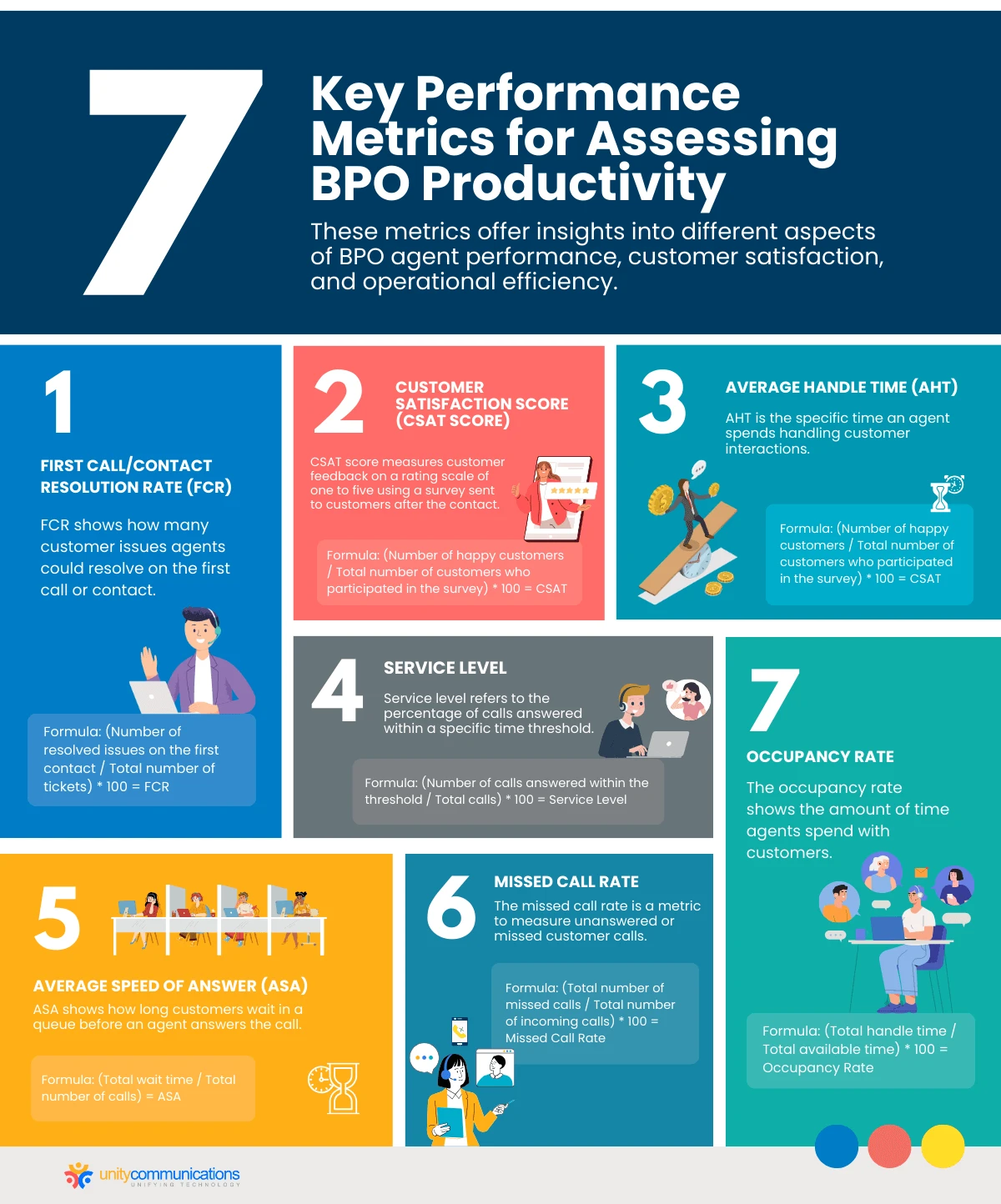Table of Contents
How would you know if your business process outsourcing (BPO) team is productive if you did not measure its performance? Simply seeing increased completed output does not mean they are doing valuable work.
Learning how productivity is calculated in BPO is a challenging feat, especially in a remote workspace. Knowing where to begin is difficult, given the many tools BPO workers use daily.
This guide explores how productivity is calculated in BPO and the metrics used to measure it. This way, you can evaluate your external team and empower them to do their best in the future.
How Is Productivity Calculated in BPO?
You can estimate productivity in BPO by looking at and measuring the work third-party agents accomplish in a given period. Work done in BPO can include answering phone calls, responding to emails, and attending team meetings.
So what is BPO? It is a business strategy that involves contracting certain functions, such as call centers, to a third party.
As agents are at the core of a BPO engagement, their workflow directly impacts the overall quality and efficiency of the outsourced process. For example, customer interactions improve if contact center agents focus on their jobs. Conversely, agent dissatisfaction and low morale lead to poor productivity, affecting the customer experience.
Now, let us see how productivity is calculated in BPO. Here is a formula to calculate productivity:
(total output / total input) *100 = productivity
Where,
- Total output is the amount of time agents spend on work-related tasks
- Total input is the amount of time agents spend working
If your call center agents work eight-hour shifts and allocate 6.9 hours to their day-to-day tasks, your call center agent productivity is:
(6.9 / 8) * 100 = 86.25%
This figure means that agents spend 86.25% of their shifts on work-related tasks and 13.75% on non-work-related activities.
This formula is applicable for getting a general understanding of your BPO agents’ productivity. However, it is more effective to break down productivity into specific goals and track them using call center productivity metrics for an accurate calculation.
Top Metrics Used to Estimate Productivity in BPO

How is productivity accurately calculated in BPO teams? With performance metrics, of course.
Many factors affect productivity regardless of the type of BPO you use; the most important is assessing the agents themselves. After all, they are key components of the outsourced work.
Here is a list of performance metrics to use when measuring agent productivity:
First Call/Contact Resolution Rate (FCR)
FCR shows how many customer issues agents could resolve on the first call or contact. A high FCR means agents assist customers immediately without multiple interactions or follow-up calls. If the agent fails to solve the problem on the first contact, customers will likely call again, taking time away from other callers.
Here is how to calculate FCR:
(number of resolved issues on the first contact / total number of tickets) * 100 = FCR
Customer Satisfaction Score (CSAT Score)
Your CSAT score measures customer feedback on a rating scale of one to five using a survey sent to customers after the call. Customers can rate how well their concern was addressed and how satisfied they are with the agent.
The CSAT score is crucial because it is the rating that your customers have given you. A high score means your call center is doing a great job delivering customer service.
Here is how to calculate the CSAT Score:
(number of happy customers / total number of customers who participated in the survey) * 100 = CSAT
Average Handle time (AHT)
AHT is the specific time an agent spends handling customer interactions. If this metric is low, your agents effectively manage their time on customer calls and resolve problems.
Note: Remember to assess the quality of your customer service in relation to reducing handling time.
Here is how to calculate AHT:
(after call work time + total talk time) / total number of customer calls = AHT
Service Level
Service level refers to the percentage of calls answered within a specific time threshold. Most call center managers want to achieve 80/20, which means they must answer 80% of calls within 20 seconds.
A high service level indicates that agents respond to customers fast and that callers need not wait for someone to answer their questions.
Here is how to calculate the service level:
(number of calls answered within the threshold / total calls) * 100 = service level
Average Speed of Answer (ASA)
ASA shows how long customers wait in a queue before an agent answers or tends to their requests. The longer the wait time, the poorer the service quality. Improving CSAT scores requires reducing ASA and enhancing agent productivity.
Note that most of your agents might answer calls within reasonable speed, and only one or two agents might take a long time, skewing your ASA rate. In this case, you must deal with the unproductive agent.
Here is how to calculate ASA:
(total wait time / total number of calls) = ASA
Missed Call Rate
The missed call rate is a metric to measure unanswered or missed customer calls for any of the following reasons:
- A queued or on-hold customer hangs up while waiting.
- The customer lost interest while waiting and hung up before an agent could answer.
- The customer did not leave a message when the voicemail came on.
Customers whose calls are not answered will likely not call back. Missing calls mean businesses could lose potential revenue, especially if the incoming call concerns a sales inquiry. Companies in the U.S. lose a whopping $62 billion per year because of poor customer service.
The missed call rate should be low; otherwise, you should optimize processes by getting more agents or asking your provider for equipment upgrades.
Here is how to calculate the missed call rate:
(total number of missed calls / total number of incoming calls) * 100 = missed call rate
Occupancy Rate
The occupancy rate shows the amount of time agents spend with customers. For instance, an agent with an occupancy rate of 80% is handling calls for 80% of their available time.
A low occupancy rate indicates that agents are not working for the majority of their time for any of the following reasons:
- Unproductive agents
- Overstaffed call center
- Low call volume
- Poor call management
- Plenty after-call work
Here is how to calculate the Occupancy Rate:
(total handle time / total available time) * 100 = occupancy rate
Challenges in Measuring Productivity in BPO

Now that you know how productivity is calculated in BPO, let us discuss the challenges of measuring the performance of third-party teams.
The biggest problem with monitoring BPO productivity is the lack of visibility for external teams. Client companies cannot know whether the third-party agents work during billable hours.
However, clients can easily solve this issue by partnering with a reliable provider. A reputable BPO company can send detailed daily end-of-day reports on your external team’s performance. This report sums up how they spent their time, so you are always in the loop about what agents are working on.
Tips for Improving Productivity in BPO Teams
Productive agents are intrinsic to providing excellent customer service. Here are some tips for improving productivity in your third-party teams:
- Improve self-service options. Note that not all customers want to speak with an agent. Most customers prefer self-service options over phone calls. Consider investing in self-service options such as knowledge bases, chatbots, and online forums.
- Train teams on multichannel communication. Training support teams to learn various communication channels, such as email, live chat, and social media, enables them to become more versatile and productive. You do not need to hire more agents to manage different platforms.
- Use the best tools and tech stack. The right equipment helps agents be more productive. Ask your BPO provider which call center software they use and if they can use the latest one to empower agents to answer more calls. Good software integrates seamlessly with other systems and reduces delays.
- Ensure continuous training and monitoring. The tips above are useless if you do not regularly monitor your team’s productivity and progress. Tracking your external team’s productivity is challenging. Hence, you should partner with a trusted BPO firm that guarantees real-time monitoring and accurate performance reports.
The Bottom Line

Hopefully, this guide answered the question, “How is productivity calculated in BPO?” Although most call center and BPO teams are always busy, effective ones are busy with the right tasks. Therefore, measuring productivity puts you at the forefront of improving performance, overall efficiency, and customer satisfaction.
Remember that productivity does not equal effectiveness. Consider quality and customer feedback. A BPO partner like Unity Communications mixes team productivity and service quality. Let’s connect to learn more.




